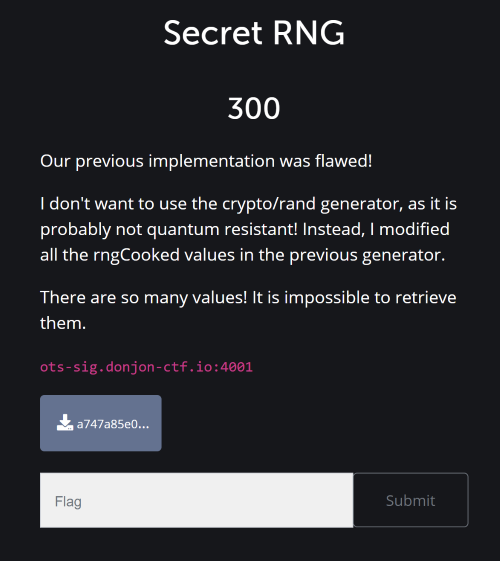Donjon CTF Writeup: Secret RNG
TLDR
This was a very nice challenge in the Donjon CTF. The goal was to reverse engineer the state of the PRNG math/rand in the Go standard library to guess the private key of a signature scheme and sign a given message. I solved this challenge by using the SMT solver Z3 to automagically recover the RNG state.
Description

Connecting to nc ots-sig.donjon-ctf.io 4001, we get:
Public key: djX6vqVMj0fTZGIhJFgN1VHLgGgaBxWEhvxp1MzB09s=
Enter signature: test
You failed! Private key was: 8GB6ClgHLz0nGU40Zwj8eKcH/CPl6sDKQEQX5cbiy1TPVf8ccI2yjr8HiOQwpwCj4VSQmS36+bIWBgkM3HO4Ny7pBvE0yGtJY9v3sVuaYeUU5h/rqYBpMjUAXBj5jfljRnVAXl50AKQvD5IYzU5IP6F5mJV/ZgT7MQ912/j/Q0+ug8Bj9q/+T6iO8tQfsui857XR/KIw85+EP5gRhUJi09Jjl36iFC2jyvqNQdjTpdJ4cQN8PO8RIAXCJlPT7upvD5uhQ0CiL+1KQRUPgWPK77SvNwUD++IboU4SBwP1DDFDrnqOZ7GmEncgT0VkLlQW9kWdfxM1HqQvSQmNqiUwK6Xps12qXi8ib07rnYkcV4eJ0QVGho6uuk8aGXhfJoArf2fGUzqhaNZIQGjsXBaoAfG7mka+SSlM4cGzvn5xA59yZ2H9H8C72ADiTtfF5cUSniT7QsMXWUjJrrsupUbOyapRH40DJ1fTeLgDZ1ly3CzN8dXKjItxcyuNONDCd5MvfdPIBsrApCY6Uu25rbG1q91C8t5YLVM0l90GoLdpJlJLfF/02jHNmkoYsc/Jyg8PyRuwBXj47mtbD/AViomNbkX2th9gUXfEVeMPzP1QqDJ6CC7sdkmdBspuyQtF6nX/pM5pXNDAOvFYuBdwfCPvCEAonXQqKUYXkqyZ82YACNhtmXgkBjkhO4b6RiOGKHVNQDqtCUmvSuk0VNebMGHrWmBSdjrM7FXVVI+f6Z7tik8ctxHYrJyU1XFervwlmAmbvhx1FOP8OwutpS9EViIne2HxN6dNaJTvVWfyPAOrdA9su7FKAh+HyrQfvlTwPEJEYW5Md9aX5jT1f2f76IiLyIG1S/gy8G/zb+WDsVVzspLV0aLw3Ce9jgJeBaMhGvZ93b+90xt86oKSDwueAM7JTjxgeNJOL0B3pr7QzlRhMRCxDl6veUfQ7o5q9YzOr1RI7cMINeyW7oQhqkyaoXa8Am4BH6LiWzmLOjMY4SiE5QPO4RVj95EhRVYFAtrrnUDMwZAftSjqhBq3qLXGNnLXm4QSwmgjaGOJ0wXqdH6BryXKALFB/hhUAFdW0YMdZzAOd27adHH2YDvDDeGvimJpAVmHDNDG1pLDHjlgXXc4QQP8TpmvhcSqJx7wgY8v/qcj00VREI+uI3F6CJScW2N8Bsa9mSzHpiyclCYkQyM4G8MEXGdfMm0CoLzeyZLf6P2sRtRjnGdbkdp3QP7frlDVOjUAe+8gsBu2K+PhyoZ6Rn+oNOMVWuftIEsy68KkEPwgy1AIwtWAEQKD3T+yRSNmRK1rznLr2HFTQJK0RI4OuBWDvmrlf4pSqC3Ri9uDcki/DOcTpVzwejOSSTrn1zYafTmeVN9JLzTHfIkdjQxSRJiOrgFxE0Rd/9iDeioj8VFBlvFkM5WX2Op2WKZefQVCuTs4ccnHt56V49yxukM0CeA=
We also get a single Go script:
|
|
It is clear that the service on ots-sig.donjon-ctf.io:4001 is the Go script. The goal of the challenge is then to find a valid signature of the message Sign me if you can given only the public key and possibly some previous private keys.
The signature scheme is the Lamport signature scheme implemented in the wots Go package. I assumed that this implementation is secure (it’s a bit unethical to exploit a 0-day in an open-source project).
Exploit
To start, I looked at the code for generating a PrivateKey from a RNG. The answer is straightforward, the private key just holds the next $N$ bytes of the RNG, where $N=B*(B+2)$ is the size of the private key, and $B$ is the size of the hash function. This challenge uses SHA256, so we have $B=32$ and $N=1088$.
So the challenge allows us to get as many subsequent private keys (from a single seed) as we want. As we have just seen, this is equivalent to being able to stream the RNG rand.New(rand.NewSource(time.Now().UnixNano())). Therefore, if we break the RNG, meaning we’re able to guess the following 1088 bytes given an arbitrary number or previous bytes, we win.
At this point, it is worth looking back at the challenge description and also line 13 in the Go script:
|
|
So the RNG used is the same as the standard math/rand but with different constants (otherwise the challenge would be straightforward since we could just bruteforce the seed). rngCooked and the RNG logic in general are defined here.
After staring at this file for a while, I found the potential vulnerability1. Here is the function to generate uint64 (which is used to generate random bytes):
|
|
For some context, rng.vec is the RNG state represented by a vector of $\texttt{rngLen}=607$ int64 elements. rng.tap and rng.feed are two counters ranging from 0 to rngLen and originally set at 333 and 606 respectively. The “vulnerability” is at line 250. Every time the function is called, the state element rng.vec[rng.feed] is replaced by the returned value2. So after having observed rngLen calls to this function Uint64, we can deduce the RNG state and thus compute the RNG’s next values, without knowing anything about the original state nor the seed.
However, in this challenge we do not get raw uint64 values from the RNG, but bytes. So, let’s see how random bytes are generated from the RNG. This is implemented here:
|
|
A few things to note:
rng.Int63is just the signed version ofrng.Uint64that we analyzed above.- The function
readworks by iteratively generating aInt63, and writing the first (little-endian) 7 bytes of this value to the buffer. - After the 7 bytes have been written, the rest is discarded, a new
Int63is generated and the process continues. - This means that we get back the first $7*8=56$ bits of every value generated by the RNG.
I think this is the appropriate time to introduce our good friend Z3.
Modelling the problem with Z3
To recapitulate:
- After observing
7*rngLenbytes, we can deduce the first 56 bits of every element of the RNG’s state. - Afterwards, we can observe 56 bits of an arbitrary number of linear combinations of state elements.
The state is a vector of $\texttt{rngLen}$ int64 elements. We can thus model them with a list of $\texttt{rngLen}$ z3.BitVec('state_i', 65) elements:
state = [z3.BitVec(f'state_{i}', 65) for i in range(rngLen)]
Then, by 1., after observing 7*rngLen bytes, I create a list masked_state of rngLen 56-bits integers and set the constraints:
s = z3.Solver()
for i in range(rngLen):
s.add(state[i] & mask == masked_state[i])
where mask = (1<<56)-1 is the 56 bits mask.
Then, by 2., whenever we observe 7 bytes seven_bytes, we can create a (little-endian) 56-bits integer from them and do the following:
x = int.from_bytes(seven_bytes, 'little')
y = state[feed] + state[tap]
s.add((y & mask) == x)
state[feed] = y
We can then repeat this process infinitely (by also decrementing the counters tap and feed).
It turns out that after 2*rngLen*7 observed bytes, Z3 manages to correctly recover the state. After that, it’s easy to solve the challenge by generating the next 1088 bytes from the RNG, give them to the wots Go package to sign the message and get the flag.
Full solution
Here is the full solution in Python:
|
|
I call the following Go script on line 75 to generate the signature:
package main
import (
"crypto/sha256"
"encoding/base64"
"fmt"
"github.com/dchest/wots"
"math/rand"
"os"
"time"
)
func main() {
var message = []byte("Sign me if you can")
rng := rand.New(rand.NewSource(time.Now().UnixNano()))
var ots = wots.NewScheme(sha256.New, rng)
priv, _ := base64.StdEncoding.DecodeString(os.Args[1])
s, _ := ots.Sign(priv, message)
fmt.Println(base64.StdEncoding.EncodeToString(s))
}
Running the Python script then outputs the flag:
The Z3 model is: sat
Congratulations! Flag: CTF{m4th_RanD_1s_s0_pr3d1cT4bl3}
Conclusion
This was a really nice challenge, especially when seen as a Z3 exercise. It’s also cool to reverse a real-world RNG that can probably be found in the wild if people forget to use crypto/rand. Also during the challenge, googling for variations of “reversing golang math/rand” didn’t get me anything, so solving this challenge kind of felt like finding a 0-day, which was nice :)